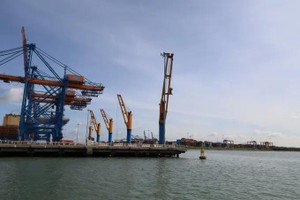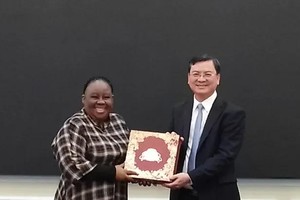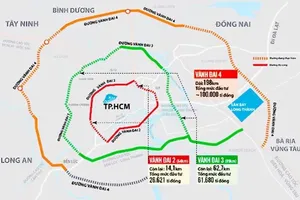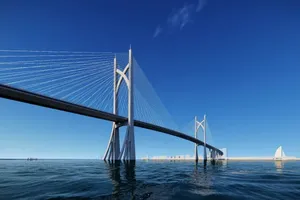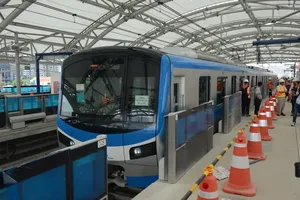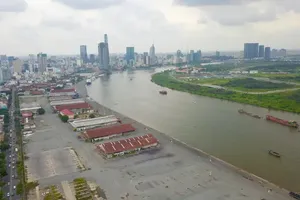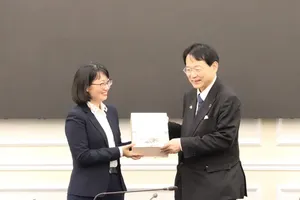 High tide causes flooding in Nguyen Thi Thap Street in District 7 in HCMC on the evening of November 6. (Photo: SGGP)
High tide causes flooding in Nguyen Thi Thap Street in District 7 in HCMC on the evening of November 6. (Photo: SGGP)
Cities are responsible for up to 70 percent of global carbon emissions
According to the United Nations Human Settlements Program (UN-Habitat), cities consume nearly 80 percent of primary energy sources and are responsible for up to 70 percent of global carbon emissions, mainly from the transport, energy, operation of buildings, and waste management. It is predicted that by 2050, two-thirds of the global population will live in urban areas. It is crucial to be aware that cities and the urban population are not only victims of climate change but also the source of the problem. The fight against climate change is also the fight with the biggest obstacle to sustainable development, and success or failure depends on urban areas. The future of the planet depends on the concerted action of governments, cities, and communities.
According to research by McKinsey in 2020, direct damages on infrastructures of a 100-year probability flood may increase from a current US$200 million-US$300 million to $500 million-$1 billion in 2050, while the remediation costs increase correspondingly from $100 million-$400 million to $1.5 billion-$8.5 billion.
In Vietnam, there are about 862 urban areas, with an urbanization rate of about 40 percent. The urban area is considered the driving force in the socio-economic and cultural development of the country, contributing up to 70 percent of GDP. However, in recent years, cities in Vietnam have been facing many serious problems due to the impacts of climate change.
In Ho Chi Minh City, according to Dr. Pham Thai Son, Viet Duc University, climate change, and urbanization lead to more frequent extreme weather, abnormal rainfall, and temperature changes (increasing urban heat island effect). The rapid urbanization process causes a lack of green space in the inner city. The suburban green belt is in danger of narrowing, along with pressure from traffic and economic benefits, and air quality. Many low-lying areas have been concreted, reducing water surface area and naturally permeable soil. Many urban areas in HCMC are prone to flooding due to heavy rains or high tides.
Increasing adaptation to climate change
Cities are said to be often exposed to cataclysms and stressful situations, including natural disasters, such as typhoons and sea-level rise, which possibly disrupt urban systems and reverse the achievements of socio-economic development that take many years to achieve. For cities to grow and prosper in the future, measures must be taken to handle changes.
Mr. Ly Khanh Tam Thao, Head of Technical Infrastructure Department under the Department of Planning and Architecture of HCMC, said that in the master plan for the HCMC area to 2050, the city had oriented development towards adaptation to climate change. Accordingly, the city will divert growth away from areas prone to flooding, discourage rampant development, build regional strategies for large industrial parks, calculate construction elevation based on tide level, rainfall, and sea-level rise. HCMC aims to become an innovative, dynamic city with a good quality of life and an attractive working environment with cultural diversity, heritage preservation, and river landscape, as well as sustainable urban infrastructure, to adapt to climate change.
To achieve these goals, the city has initially focused on some orientations, including developing safe, climate-resilient regions, restricting urban expansion, especially in areas affected by flooding, promoting compact, mixed-use, and public transport-oriented urban development, limiting the loss of agricultural land, and reducing the heat island effect.
According to Prof.-Dr. Mai Trong Nhuan, former Director of Vietnam National University - Hanoi, in order to plan and develop urban areas that are capable of coping with and adapting to climate change, cities in Vietnam need to focus on the planning stage. Accordingly, in land-use planning and urban design, it is necessary to develop urban land in low-risk areas, increase water surface, natural soil surface, and trees to limit flooding, and create urban landscapes. The planning of the technical infrastructure system needs to ensure safety for the urban population, dyke system, civil works, and technical infrastructure to meet the requirements of disaster prevention and mitigation. Good urban planning and management will contribute to the efficient and sustainable use of resources and energy.
According to research by McKinsey in 2020, direct damages on infrastructures of a 100-year probability flood may increase from a current US$200 million-US$300 million to $500 million-$1 billion in 2050, while the remediation costs increase correspondingly from $100 million-$400 million to $1.5 billion-$8.5 billion.
In Vietnam, there are about 862 urban areas, with an urbanization rate of about 40 percent. The urban area is considered the driving force in the socio-economic and cultural development of the country, contributing up to 70 percent of GDP. However, in recent years, cities in Vietnam have been facing many serious problems due to the impacts of climate change.
In Ho Chi Minh City, according to Dr. Pham Thai Son, Viet Duc University, climate change, and urbanization lead to more frequent extreme weather, abnormal rainfall, and temperature changes (increasing urban heat island effect). The rapid urbanization process causes a lack of green space in the inner city. The suburban green belt is in danger of narrowing, along with pressure from traffic and economic benefits, and air quality. Many low-lying areas have been concreted, reducing water surface area and naturally permeable soil. Many urban areas in HCMC are prone to flooding due to heavy rains or high tides.
Increasing adaptation to climate change
Cities are said to be often exposed to cataclysms and stressful situations, including natural disasters, such as typhoons and sea-level rise, which possibly disrupt urban systems and reverse the achievements of socio-economic development that take many years to achieve. For cities to grow and prosper in the future, measures must be taken to handle changes.
Mr. Ly Khanh Tam Thao, Head of Technical Infrastructure Department under the Department of Planning and Architecture of HCMC, said that in the master plan for the HCMC area to 2050, the city had oriented development towards adaptation to climate change. Accordingly, the city will divert growth away from areas prone to flooding, discourage rampant development, build regional strategies for large industrial parks, calculate construction elevation based on tide level, rainfall, and sea-level rise. HCMC aims to become an innovative, dynamic city with a good quality of life and an attractive working environment with cultural diversity, heritage preservation, and river landscape, as well as sustainable urban infrastructure, to adapt to climate change.
To achieve these goals, the city has initially focused on some orientations, including developing safe, climate-resilient regions, restricting urban expansion, especially in areas affected by flooding, promoting compact, mixed-use, and public transport-oriented urban development, limiting the loss of agricultural land, and reducing the heat island effect.
According to Prof.-Dr. Mai Trong Nhuan, former Director of Vietnam National University - Hanoi, in order to plan and develop urban areas that are capable of coping with and adapting to climate change, cities in Vietnam need to focus on the planning stage. Accordingly, in land-use planning and urban design, it is necessary to develop urban land in low-risk areas, increase water surface, natural soil surface, and trees to limit flooding, and create urban landscapes. The planning of the technical infrastructure system needs to ensure safety for the urban population, dyke system, civil works, and technical infrastructure to meet the requirements of disaster prevention and mitigation. Good urban planning and management will contribute to the efficient and sustainable use of resources and energy.



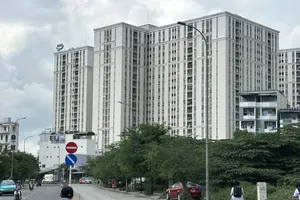
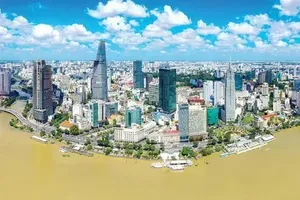

)

